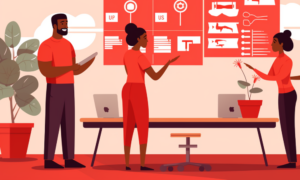Debra Corey: Change needn’t be challenging – how to ride the workplace rollercoaster
- 6 Min Read
Debra Corey shares practices, based in her experience over the last 20 years, to help you deal with the constant change in today’s workplace.
- Author: Debra Corey
- Date published: Sep 14, 2022
- Categories

If we have learned anything over the last few years, it is that the only thing we can predict is that change will continue to happen.
And with all this change, life and the workplace in general is feeling more and more like a rollercoaster. There are ups, downs, and many twisty-windy turns that we encounter as we move from one challenge to another. Some are challenges we’ve seen or have dealt with in the past, and others are like the rollercoasters that catapult you into darkness, not knowing where you are and how to feel and act.
I thought it would be helpful to share some practices to help you deal with this change. They come from the insights and lessons I’ve learned throughout my over 20 years as an HR leader and riding my fair share of rollercoasters.
Understand the change
This first tip is an obvious one, which is to understand the change. Not only what it means, but the impact it can and may have on your business and your people. Look at it in many dimensions and perspectives, mapping it out so that it paints a clear picture of the change itself. This is important to do upfront so that this picture can help steer and drive your approach and decisions, giving you the focus and direction, you need.
Understand what others are doing
It’s also important to gain an understanding of what other companies are doing to handle the change. We all can and should learn from each other, seeing how we are handling the change for our business and people. We need to remember that we are all different, so what may work for one company may not work for us. Use this information as a data point, and then come up with our own solution. For example, in respect to the latest rollercoaster ‘twist’, cost of living challenges, surveys like the one recently released from PwC are helpful to understand how other businesses are responding. In this situation, they report that more than eight out of ten large businesses are taking action in the form of additional pay increases (50%), providing one-off bonuses (40%) and non-financial interventions (15%).
Understand your people
The final element of understanding, and a critical one, is to understand your people. Listen to them, understanding how the changes will impact them in both the short and long term. Key to listening is asking the right questions. A technique I share in one of my books is called ‘The 5 Whys,’ which is all about asking probing questions to help you get to the root of the situation and problem, using this to come up with the solution(s).
Here’s an example using a real-life situation when my daughter came to me to borrow money. Had I not asked these probing questions I never would have truly understood the situation and taken the correct action (which was to lend her the money and teach her about the evils of some loan companies):
- Why do you need to borrow money from me? I need to make a payment.
- Why do you need to make a payment? I need to pay off a loan.
- Why do you need to pay off a loan? I don’t want to pay any more interest on it.
- Why don’t you want to pay any more interest on it? Because I just found out that they are charging me an insane amount of interest?
- Why did you take out this loan? Because I didn’t read the fine print and understand it.
Adopt a flexible approach
When I started out in the workplace, when you put in place an HR programme it was there for many years, set in stone as the expression goes. Gone are these days, for going back to the rollercoaster analogy, something that may work when you’re going up certainly won’t work when you’re plummeting down at full speed. For this reason, you need to adopt a flexible approach to how you design and deliver your HR programmes. Yes, they need to be based on a solid strategy that is driven by your mission and values, but the programmes themselves need to be able to adapt as changes are thrown your way.
Two things to think about as you do this are:
- Be open and honest with your people – For example, at a previous company when I announced changes in our benefit programmes I told my people upfront that these were to be in place for a year. I didn’t promise them to continue after this time, letting them know that we would review them and come back with any further changes.
- Review things often – Related to the previous point, it’s important to review what you have in place often. This certainly needs to be done as soon as you face new challenges and rollercoaster ‘twists,’ but also on a more regular basis. Using benefits as an example again, no longer can we review our programmes every three or five years, but at least every year.
Get off the rollercoaster from time to time
Riding a rollercoaster can be a multisensory experience, which is why many of us love them. However, they also have an impact on your body, e.g., heart rate and blood pressure increases, your brain rattles around in your skull, your inner ear gets confused. For this reason, we don’t go around and around on a rollercoaster ride but get off and take a break. The same needs to happen when it comes to the workplace rollercoaster, with us walking away from and taking a break from it from time to time. This helps us be more productive and creative, supporting our overall wellbeing. And as a recent study by Workvivo showed, 98% of HR professionals are burned out, showing that more of us need to take care of ourselves and get off the rollercoaster.
I hope you’ve found these practices useful in helping you as you continue to ride the workplace rollercoaster. Do pull them out and keep them in mind as you hit the highs, lows, twists, and turns.









